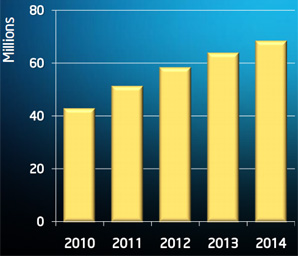Intel Announces New Z670 For Tablets
Intel is on record as talking about MIDs, netbooks, and the device ecosystem it envisioned in between long before much of the current tablet craze, but the company has been oddly quiescent in recent months. Talk of dual-core ARM-based products, from Tegra to the iPad 2, has dominated the industry, with scarcely a peep from Intel. As of now, that's changed. Intel has unveiled its first Atom explicitly aimed at the tablet market. It's the Atom Z670, and it's Intel's chosen SoC for reclaiming lost mindshare that's been snapped up by other solutions.


That's netbooks on the left, tablets on the right
Intel continues to foresee strong growth in tablets with moderate continued gain for netbooks. Note that the netbook graph (in yellow) starts in 2010 for a reason. If it went back to the market segment's debut, the drop between 2009 and 2010 would be significant. Leaving out that info makes for prettier lines (and a better record as an industry forecaster).

Intel's argument for the continued importance of both segments is neatly captured in the Venn diagram above. Now we come to the crux of the matter, and the established argument (from Intel's perspective) that the Z670 Atom is a platform for any choice of device. Intel notes that the chip supports Windows 7, Android, and MeeGo, operates at 1.5GHz, and can access both Intel's Appup center and MeeGo's value proposition. More cracks are sprouting in the Wintel Alliance—once upon a time not so long ago, Intel would've included a slide about the many benefits of Windows 7 support, as opposed to claiming MeeGo is a platform that "thinks like you do." The chip has a TDP of 3W, supports Intel Rapid Burst Technology (meaning it'll self-overclock for very brief periods of time), but it's a single-core / dual-threaded chip.
The Atom component of the SoC, in fact, offers virtually nothing to get excited about. It incorporates advanced SpeedStep features that first-generation Intel Atoms lacked, but it lacks 64-bit support. When all is said and done, it's hard to get excited about a core whose performance has scarcely changed in three years.
Luckily, the GMA 600 (built, like GMA500, on Imagination Technologies PowerVR SGX 535). The GMA600 can run at double the clockspeed of its predecessor and offers commensurately higher performance. Its features, including 1080P output, are what put the new Z670 on par with what other tablets are offering. The GMA 600 isn't new either—it debuted when Lincroft did—but the higher TDP and discussion of video features implies the GPU will be clocked higher than what we saw with previous Lincroft products.
We'll be watching to see if the new Z670 is followed by fresh talk of Intel tablets to challenge the likes of Motorola's Xoom or the iPad 2. We suspect Intel is keen to regain mindshare in these areas—it's unusual for non-x86 products to gain prominence in an x86 market for very long.


That's netbooks on the left, tablets on the right
Intel continues to foresee strong growth in tablets with moderate continued gain for netbooks. Note that the netbook graph (in yellow) starts in 2010 for a reason. If it went back to the market segment's debut, the drop between 2009 and 2010 would be significant. Leaving out that info makes for prettier lines (and a better record as an industry forecaster).

Intel's argument for the continued importance of both segments is neatly captured in the Venn diagram above. Now we come to the crux of the matter, and the established argument (from Intel's perspective) that the Z670 Atom is a platform for any choice of device. Intel notes that the chip supports Windows 7, Android, and MeeGo, operates at 1.5GHz, and can access both Intel's Appup center and MeeGo's value proposition. More cracks are sprouting in the Wintel Alliance—once upon a time not so long ago, Intel would've included a slide about the many benefits of Windows 7 support, as opposed to claiming MeeGo is a platform that "thinks like you do." The chip has a TDP of 3W, supports Intel Rapid Burst Technology (meaning it'll self-overclock for very brief periods of time), but it's a single-core / dual-threaded chip.
The Atom component of the SoC, in fact, offers virtually nothing to get excited about. It incorporates advanced SpeedStep features that first-generation Intel Atoms lacked, but it lacks 64-bit support. When all is said and done, it's hard to get excited about a core whose performance has scarcely changed in three years.
Luckily, the GMA 600 (built, like GMA500, on Imagination Technologies PowerVR SGX 535). The GMA600 can run at double the clockspeed of its predecessor and offers commensurately higher performance. Its features, including 1080P output, are what put the new Z670 on par with what other tablets are offering. The GMA 600 isn't new either—it debuted when Lincroft did—but the higher TDP and discussion of video features implies the GPU will be clocked higher than what we saw with previous Lincroft products.
We'll be watching to see if the new Z670 is followed by fresh talk of Intel tablets to challenge the likes of Motorola's Xoom or the iPad 2. We suspect Intel is keen to regain mindshare in these areas—it's unusual for non-x86 products to gain prominence in an x86 market for very long.

